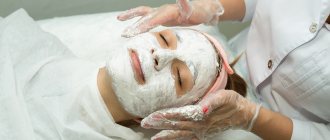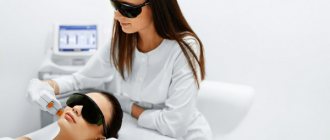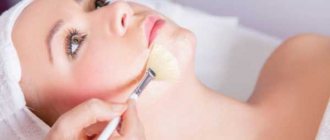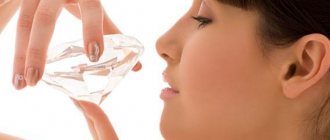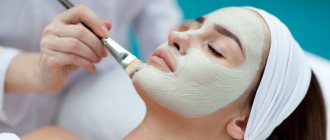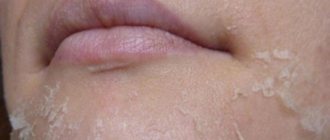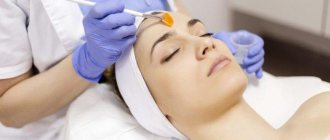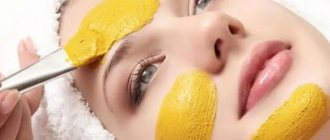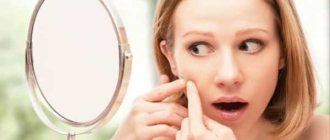Peeling (from English PEEL - peel, peel) is the process of removing several layers of skin with defects to improve the aesthetic qualities of the skin. In cosmetology, chemical peels, ultrasound, laser, and mechanical peeling are used to refresh and rejuvenate the face and body. Chemical peeling is based on the use of acids.
According to the level of impact, they are distinguished: superficial peeling, medium and deep. To achieve a certain result, use the required acid solution with the required concentration. One of these popular chemical peels is the TCA peel. What it is and how the procedure is performed will be discussed in more detail in this article.
TCA peeling - what is it?
TCA peeling is a peeling containing a solution with trichloroacetic acid (TriChloracetic Acid). Chemical TCA peeling is needed to perform superficial and medium peeling. Previously, I did deep TCA peeling, but today I abandoned this procedure. The TCA peeling procedure is a medical procedure and is performed by a cosmetologist.
Peeling should be done in a medical center, not at home. The cosmetologist individually selects the concentration of peeling, recommends pre-peeling preparation and a recovery plan in the post-peeling period.
Mechanism of action of chemical TCA peeling
The mechanism of action is the destruction of protein components of the skin (chemical burn of the skin). In the first days, skin redness, swelling, and inflammation are noted. The healing process begins, it averages 7 days. New elastic and collagen fibers are formed, which helps to increase skin elasticity and smooth it. Next, the damaged skin is rejected and exfoliated, replacing it with new areas of cells.
Superficial TCA peeling
Superficial TCA peeling leads to release from the upper layers of the skin to the papillary layer. A 15% or 20% (up to 25%) TCA solution is applied to the skin for up to 15 minutes. The first procedure is carried out with a minimum acid concentration of 15%, the next time the concentration is increased by 5%. The cosmetologist selects the number of procedures and the duration of action of the acid individually, taking into account the person’s gender, age, skin color, its quality and level of damage.
Medium TCA peeling
Medium TCA peeling causes a deeper effect, down to the reticular layer of the skin (its upper level). With it, solutions with a concentration of 25% to 35% TCA are exchanged. To achieve results and reduce the risk of side effects, peelings are combined, using acid with minimal concentrations. The cosmetologist prescribes the number of procedures and duration of peeling individually.
Deep TCA peeling
Deep TCA peeling causes maximum destructive effect on the skin up to the middle layers of the reticular layer. The use of solution concentrations above 35% allows peeling to be applied locally (on a limited area of skin) or in a targeted manner.
Procedure Properties
The effectiveness of peeling is due to solubility with subsequent elimination of dead particles simultaneously with enhanced restoration of regenerating cellular molecules. Concentrated acid variations are divided into superficial (up to 15%), medium (20-25% to 30%) and deep (40%) exfoliation. The effectiveness of the therapy depends on the number of sessions, the depth of absorption of the active substance, and the presence of additional components.
Action of the main component of the composition
Trichloroacetic acid, the leading component, has the following properties:
- Cleansing. By separating the stratum corneum of dead cells, the acid frees the epidermis of dirt and fat.
- Regeneration. The acidic effect on the deep layer of the skin activates the process of cellular revival, which increases barrier properties.
- Bactericidal properties. The active components narrow the epidermal pores, reducing the fat secretion of the sebaceous glands.
- Stimulation. An increase in capillary permeability provokes the production of organic collagen and improves metabolism.
How many TCA peels are required?
How many TCA peels are needed? The quantity depends on specific factors, everything is individual. The cosmetologist determines the course for each person. Superficial peeling affects the superficial layers, so it can be applied more often at intervals of 2 weeks to a month. Medium peeling is performed 1 or 2 times a year. Sometimes superficial and medium peeling procedures are alternated. Combinations of peels with reduced concentrations of acid solutions are effective to reduce the risk of adverse reactions (for example, 35% TCA solution + Jessner solution).
The lower the acid concentration, the less destructive effect and the less pronounced effect of use.
Important! When using higher concentrations of acid, the effect is achieved faster, but the risk of burns and scarring increases!
Contraindications for TCA peeling
- Acute period of infectious disease (ARVI, herpes, other viral infections, papillomas and warts).
- Purulent-inflammatory skin diseases (danger of spreading bacterial infection).
- New growths on the skin.
- Dark skin color.
- Allergic skin diseases (atopic dermatitis, neurodermatitis, eczema, etc.).
- Pregnancy, breastfeeding period.
- The use of retinoids (Retin A, Roaccutane) and antibiotics that increase skin sensitivity to UV rays.
- Simultaneous use of traumatic cosmetic procedures (dermabrasion, hair removal, etc.).
Contraindications for TCA peeling are determined by a cosmetologist. The list of contraindications may be expanded, so you need to visit a doctor for a detailed examination and examination.
Contraindications
There are many prohibitions on this peeling. At the first visit to the clinic, the patient must tell the doctor about all the diseases and conditions that have bothered him over the past six months, about taking any medications, pregnancy, and breastfeeding.
Attention! During some diseases, the result obtained is completely unpredictable, and serious complications are also very common.
When TCA peeling is prohibited:
- in the spring-summer period, the first month of autumn - when the sun is excessively active;
- benign and malignant neoplasms;
- fungal diseases;
- any infectious diseases;
- expectant and nursing mothers;
- wound skin defects;
- presence of a tan;
- taking retinoids (tablets to treat skin diseases);
- undergone surgery on the face;
- presence of allergies;
- disruptions in the functioning of the endocrine system.
A more detailed list of specific diseases should be checked with a cosmetologist.
It is not recommended to hide your life history from the doctor, otherwise the specialist is not responsible for the negative result obtained, which will certainly be reflected on the face.
It is also worth holding off on cleansing the skin during menstruation, and if the dermis is sensitive, avoid using aggressive acids altogether.
When and how to do TCA peeling?
Choose the autumn-winter season to start procedures. At this time of year, solar insolation is minimal. The skin after the procedure is very sensitive and when exposed to sunlight, pigmentation may develop excessively.
Preparation before peeling is required. A month before the mid-peel, sunscreens with a high level of protection (SPF 30-50) are used. Before going to bed, tretinoin is prescribed externally and skin bleaching agents are applied.
The mid-peeling procedure is painful. At the discretion of the doctor, painkillers may be recommended for 1 day; a course of prevention of herpes infection is recommended for all patients.
Immediately before peeling, the skin is cleansed and degreased. The face is washed with soap and treated with a sponge moistened with an alcohol solution.
Identify areas of skin that require caution when applying acid. Apply protective Vaseline to the corners of the eyes, lips, surface of the lips, wings of the nose and other areas. When applying spot peeling, markings are performed.
General recommendations
To help your skin recover faster, you need to know the basics of care after chemical peeling.
We invite you to study the advice cosmetologists give to their patients during consultations before starting the procedure:
within 12 hours after the session it is prohibited:
- wash your face with water and other means;
- touch the surface of the treated epidermis with your hands;
- apply any cosmetic compositions to the skin surface;
- going out.
after 4 days after the procedure, you are allowed to use:
- light gels and cleansing foams;
- moisturizing creams containing panthenol;
- When going outside, be sure to wear a hat and safety glasses.
within 2 weeks after peeling:
- You can use cleansing and care products prescribed by a cosmetologist, taking into account your skin type and the degree of injury received. They should contain moisturizing, anti-inflammatory, tonic components, as well as antioxidants;
- It is prohibited to use any decorative cosmetics (powder, foundation, blush, etc.) intended for damaged areas of the face;
- Do not touch the skin with your hands or perform massage;
- It is contraindicated to tear off the crusts that form on the epidermis, under the surface of which processes of regeneration and cellular renewal take place, which can be disrupted and result in disfiguring scars. If the skin is very flaky, you can use disinfected scissors to carefully trim the edges of these formations so that they do not hang from the face;
- It is prohibited to use scrubs and peeling compounds that have a traumatic effect;
- It is not recommended to change the series of cosmetics used at this time in order to exclude the possibility of an allergic reaction to new products;
- Do not sunbathe on the beach or visit a solarium during this period of time;
- It is strictly forbidden to visit baths, saunas, swimming pools, and open reservoirs during this period;
- It is very risky to use homemade face masks, as you can get an infection that can lead to serious complications and long-term treatment.
The cosmetologist who performed the peeling procedure on you must tell you in detail about the methods of skin care throughout the entire rehabilitation period. If he did not do this, then contact him by phone and find out all the points of interest.
One of the main complications after peeling is redness and itching.
TCA peeling at home: what are the dangers?
TCA is an aggressive and toxic substance. Experience and caution are required when working with TCA as it may cause harm to the skin. If the procedure is carried out incorrectly, scarring may form, areas of hyperpigmentation may appear, deep burns may occur with damage to the deep layers of the skin, damage to the germ layer of the skin and hair follicles. For home use, milk and glycolic peels are safer.
Important: doing TCA peeling at home is dangerous!
Care after TCA mid-peel
The skin requires special care after peeling. During the first day, swelling and an inflammatory reaction with redness of the skin are observed. The cosmetologist prescribes treatment, which includes anti-inflammatory drugs, local anti-inflammatory ointment and cold water compresses.
After inflammation subsides, peeling begins. For peeling, moisturizing and emollient preparations are used; the frequency and dose are prescribed by the doctor. Gently wash your face 2 times a day with soap, without rubbing or intense exposure. The resulting crusts cannot be removed by force, as this may contribute to the formation of scars. Avoid skin exposure to sunlight and use sunscreen for 3 months.
Side effects and complications
Immediately after the procedure, side effects may occur, which in most cases are normal:
- swelling in the treated part;
- skin redness;
- tightness and dryness of the skin;
- peeling.
All these unpleasant sensations are eliminated with the help of nourishing and moisturizing creams prescribed by the doctor.
But sometimes, due to the individual characteristics of the body or the inexperience of the cosmetologist, the following complications may arise:
- lack of effect - pigmentation does not always go away after the procedure, post-acne scars and other defects may remain due to the characteristics of the body;
- increased skin sensitivity;
- pigmentation, post-inflammatory or traumatic;
- the appearance of white spots on the skin;
- uneven surface at the site of scar removal;
- ineffectiveness in the treatment of acne;
- scar formation.
The risk of developing such complications increases with age due to a decrease in the regenerative ability of the skin after injury.
Complications after peeling
After peeling, complications may occur: infection, prolonged redness and swelling. This is the result of violating the recommendations of a cosmetologist or incorrectly performing the procedure, underestimating contraindications (simultaneous use of mechanical peeling, other local effects), or the use of local drugs. Dark-skinned individuals develop hyperpigmentation, and hyperpigmentation can also appear when exposed to the sun without using sunscreen.
Important: to reduce the risk of complications, you need to perform pre-peeling preparation and follow all doctor’s recommendations!
What to do if there is pigmentation on the face after TCA peeling?
Go to a cosmetologist, he will assess the scale and give the necessary recommendations. To prevent pigmentation, use high-protection sunscreens and avoid sun exposure to the skin. Choose the autumn-winter period for cosmetic procedures.
Advice! Women benefit from wearing wide-brimmed hats to protect themselves from the sun!
What is yellow peeling and is it more effective than TCA peeling?
Yellow peeling is a type of chemical peeling. The composition includes retinoic acid and additional components that color it yellow. Retinoic acid is a derivative of vitamin A. Peeling is carried out by a cosmetologist in a medical center. The action is aimed at restoring a healthy complexion, combating skin imperfections, and has a brightening effect. Suitable for performing superficial and medium peeling. The effectiveness will be determined by a specialist, taking into account the patient’s initial problems and the quality of the skin. For a specific person, a way to solve the problem is selected individually.
What care products are best and should I use sunscreen?
Basic care depends on the complexity and depth of impact of the procedure. After peeling, it is important to know what to apply to your face in order to properly moisturize and protect the skin from ultraviolet rays, which negatively affect the process of renewed skin and provoke pigmentation. Before leaving home in any weather conditions, be sure to apply sunscreen.
To eliminate the lack of fluid, it is important to drink at least two liters of purified water per day.
Upon completion of yellow (retinoic) skin cleansing
Facial cleansing using retinoic acid requires proper post-peeling care that will protect the skin from bacteria and infections.
We recommend: Why is your face red, flaky or swollen after peeling and what can you do to eliminate the problems?
Cosmetologists recommend using panthenol-based products that promote rapid recovery. Care should include the use of:
- natural balms with restorative properties;
- medicinal masks containing enzymes and lactic acid;
- use sprays with thermal water.
Suitable:
- Shea Butter;
- cranberry extract;
- panthenol.
You should start using products the next day after peeling, choosing products depending on your skin type. It is necessary to use protective preparations against ultraviolet radiation, with an increased degree of protection (SPF from 35 and above), applying them in a thick layer throughout the week.
The selected sunscreen is applied to the skin not only during the skin healing period, but also for another two months.
Deep (chemical)
Deep peeling using special chemicals, including phenol, can remove:
- scars;
- wrinkles;
- old acne scars and pigmentation on the face.
During the first two weeks, it is necessary to use antibacterial, anti-inflammatory and healing agents. Reception required:
- antibiotics;
- painkillers;
- antiviral and antihistamine drugs as prescribed by a cosmetologist.
- During the first three days, contact with water is prohibited.
You cannot wash your face or brush your teeth; you must drink water only through a straw. In the first days, lotions are made from a weak solution of acids, compresses, the skin is treated with medicinal ointment or Vaseline. - On the third day, the face is treated with a special cream and bandages are made, which provide additional protection and accelerate the detachment of old tissues.
- The procedures are carried out over the next two weeks.
To avoid infection, inflammation and skin pigmentation, the face should not be touched with hands during the recovery period. Until the epidermis is completely restored, the following should be applied:
- wound healing ointments;
- products with hyaluronic acid and panthenol;
- sunscreens;
- lotions and sprays.
Forbidden:
- treat the skin with products containing alcohol;
- wipe your face with a hard towel;
- apply scrubs;
- is in the sun;
- sunbathing, solarium;
- visit baths and saunas.
TCA
Peeling is based on trichloroacetic acid and perfectly cleanses and rejuvenates the skin. It is less aggressive compared to other peels and is accompanied by fewer complications. During the first two days, it is recommended to avoid skin contact with water. Should be used:
- lotions;
- foams and creams;
- ointments with zinc;
- copper and ceramides;
- moisturizing and regenerating preparations as prescribed by the attending physician.
It is strictly prohibited:
- make compresses;
- steam the skin and peel off the resulting film;
- go to the sauna or pool;
- sunbathe and visit the solarium.
After inflammatory processes have reduced and swelling has subsided, nourishing and moisturizing agents should be used.
TCA peeling: real reviews
I don't know what happened to my skin during my student days, but it was just terrible. The skin is oily, there is a lot of acne, enlarged pores, constant inflammation (probably, in addition to heredity and adolescence, this was facilitated by student fast food food and an unhealthy lifestyle, as well as a bunch of various creams and ointments that I generously stuffed my exhausted skin with). TCA peeling was recommended by a dermatologist, who was recommended by a friend after college. The procedure was painful and very unpleasant for me. To evaluate its effectiveness, I will attach my photos before and after peeling.
The skin after it was red for a couple of days and itchy a little, so I had to take a couple of days off from work. But literally within a month the effect was noticeable - the number of inflamed pores decreased, the skin seemed to be renewed from the inside, so I was satisfied with the effect.
Indications
As a rule, if there is one minor problem, acid peeling is not used.
The risk is justified only if several defects are present at once, which are an indication for the procedure.
In what cases is deep cleaning recommended:
- the first signs of age on the face - wrinkles, sagging tissues;
- scars, stretch marks;
- extensive pigment spots;
- enlarged pores, rashes, post-acne.
You should contact a qualified cosmetologist so that he can objectively assess the condition of your facial skin and decide on the advisability of performing TCA.
An illiterate approach to treatment can provoke even greater complications.
What is ferul peeling and expert reviews about the procedure. Watch a video of facial ozone therapy here.
At this address https://cosmetolog-expert.ru/plastika-litsa/protseduryi/kak-izbavitsya-ot-postakne.html we will find out how you can get rid of post-acne on your face.
